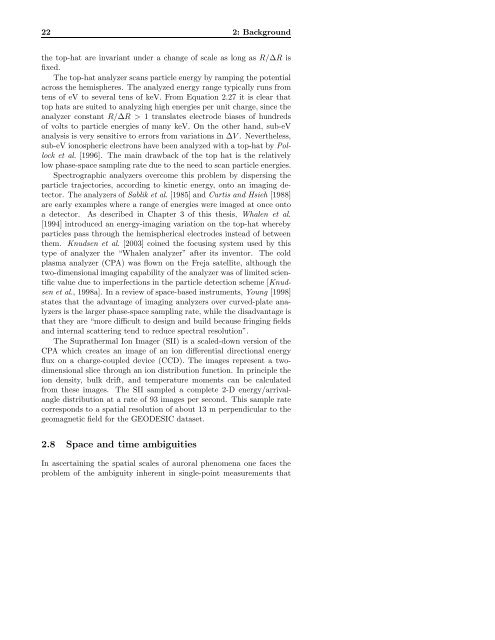PhD thesis - Institute for Space Research - University of Calgary
PhD thesis - Institute for Space Research - University of Calgary
PhD thesis - Institute for Space Research - University of Calgary
Create successful ePaper yourself
Turn your PDF publications into a flip-book with our unique Google optimized e-Paper software.
22 2: Background<br />
the top-hat are invariant under a change <strong>of</strong> scale as long as R/∆R is<br />
fixed.<br />
The top-hat analyzer scans particle energy by ramping the potential<br />
across the hemispheres. The analyzed energy range typically runs from<br />
tens <strong>of</strong> eV to several tens <strong>of</strong> keV. From Equation 2.27 it is clear that<br />
top hats are suited to analyzing high energies per unit charge, since the<br />
analyzer constant R/∆R > 1 translates electrode biases <strong>of</strong> hundreds<br />
<strong>of</strong> volts to particle energies <strong>of</strong> many keV. On the other hand, sub-eV<br />
analysis is very sensitive to errors from variations in ∆V . Nevertheless,<br />
sub-eV ionospheric electrons have been analyzed with a top-hat by Pollock<br />
et al. [1996]. The main drawback <strong>of</strong> the top hat is the relatively<br />
low phase-space sampling rate due to the need to scan particle energies.<br />
Spectrographic analyzers overcome this problem by dispersing the<br />
particle trajectories, according to kinetic energy, onto an imaging detector.<br />
The analyzers <strong>of</strong> Sablik et al. [1985] and Curtis and Hsieh [1988]<br />
are early examples where a range <strong>of</strong> energies were imaged at once onto<br />
a detector. As described in Chapter 3 <strong>of</strong> this <strong>thesis</strong>, Whalen et al.<br />
[1994] introduced an energy-imaging variation on the top-hat whereby<br />
particles pass through the hemispherical electrodes instead <strong>of</strong> between<br />
them. Knudsen et al. [2003] coined the focusing system used by this<br />
type <strong>of</strong> analyzer the “Whalen analyzer” after its inventor. The cold<br />
plasma analyzer (CPA) was flown on the Freja satellite, although the<br />
two-dimensional imaging capability <strong>of</strong> the analyzer was <strong>of</strong> limited scientific<br />
value due to imperfections in the particle detection scheme [Knudsen<br />
et al., 1998a]. In a review <strong>of</strong> space-based instruments, Young [1998]<br />
states that the advantage <strong>of</strong> imaging analyzers over curved-plate analyzers<br />
is the larger phase-space sampling rate, while the disadvantage is<br />
that they are “more difficult to design and build because fringing fields<br />
and internal scattering tend to reduce spectral resolution”.<br />
The Suprathermal Ion Imager (SII) is a scaled-down version <strong>of</strong> the<br />
CPA which creates an image <strong>of</strong> an ion differential directional energy<br />
flux on a charge-coupled device (CCD). The images represent a twodimensional<br />
slice through an ion distribution function. In principle the<br />
ion density, bulk drift, and temperature moments can be calculated<br />
from these images. The SII sampled a complete 2-D energy/arrivalangle<br />
distribution at a rate <strong>of</strong> 93 images per second. This sample rate<br />
corresponds to a spatial resolution <strong>of</strong> about 13 m perpendicular to the<br />
geomagnetic field <strong>for</strong> the GEODESIC dataset.<br />
2.8 <strong>Space</strong> and time ambiguities<br />
In ascertaining the spatial scales <strong>of</strong> auroral phenomena one faces the<br />
problem <strong>of</strong> the ambiguity inherent in single-point measurements that


